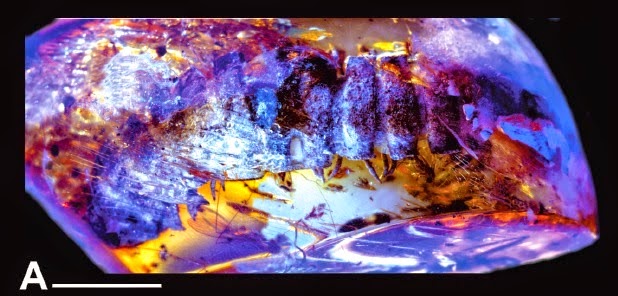Polydesmid Millipedes of the family Paradoxosomatidae are found from
South and Southeast Asia to Australia,
dominating Millipede faunas in many areas. With over 1000 species in 200 genera
the Paradoxosomatidae is probably the most specious group of Polydesmid
Millipedes. The genus Tylopus is
found in southern China, Myanmar, Laos,
Thailand and Vietnam. With
52 described species, 29 of which have been recorded in Thailand, it is
one of the largest genera in the Paradoxosomatidae.
In a paper published on the journal ZooKeys on 18 August 2014, Natdanai
Likhitrakarn of the Division of Plant Protection at Maejo University, Sergei Golovatch of the Institute for Problems of Ecology and Evolution at the Russian Academy of Sciences and Somsak Panha of
the Animal Systematics Research Unit at Chulalongkorn University, describe three
new species of Tylopus from Thailand.
The first new species is named Tylopus corrugatus,
in reference to a series of ridges on the dorsal part of its body segments. The
species is described from 7 male, five female and two juvenile specimens collected
in the Doi Inthanon National Park in Chiang Mai Province. The females are on average
slightly longer than the males, at 16.5–21.0 mm, compared to 15.5–18.2 mm. They
are brown in colour with darker backs and lighter undersides.
Tylopus corrugatus, male specimen in dorsal view. Likhitrakarn et al. (2014).
The second new species is named Tylopus parahilaroides,
in reference to its similarity to the previously described species Tylopus hilaroides (‘parahilaroides’ means ‘beside hilaroides’).
The species is described from two specimens, one male and one female, the male
being 34 mm in length and the female 33 mm. They are reddish brown in colour,
with yellowish limbs.
Tylopus parahilaroides, male specimen in dorsal view. Likhitrakarn et al. (2014).
The third new species is named Tylopus trigonum,
in reference to the triangular markings on the dorsal surface of its body
segments. The species is described from two male and three female specimens,
collected from beside two waterfalls in Umphang District in Tak Province.
The males are on average larger than the females, at 21.2–27.8 mm, compared to 22.1–24.0
mm. They are light brown in colour, with a dark brown dorsal surface, which has
a series of lighter triangles.
Tylopus trigonum, male specimen in dorsal view. Likhitrakarn et al. (2014).
See also…
 Two new species of Flat-backed Millipede from Miocene Mexican amber. Millipedes, Diplopoda, are highly successful soil dwelling
Arthropods found in soil in all temperate and tropical...
Two new species of Flat-backed Millipede from Miocene Mexican amber. Millipedes, Diplopoda, are highly successful soil dwelling
Arthropods found in soil in all temperate and tropical...
Centipedes (Myripoda) are carnivorous terrestrial Arthropods with
elongate, multi-segmented bodies, having one pair of legs per body
segment. The number of legs varies highly, from under 20 to over 300,
though the number of pairs is always odd. The first pair of limbs is
modified to form a pair of venomous forcipules (claws) used to subdue
prey. There are around 3000...
The Millipede Hoplatessara luxuriosa was first described under the name Strongylosoma luxuriosum by the Italian entomologist Fillipo Silvestri in 1895, based upon
specimens apparently collected at Sorong in New...
Follow Sciency Thoughts on Facebook.





